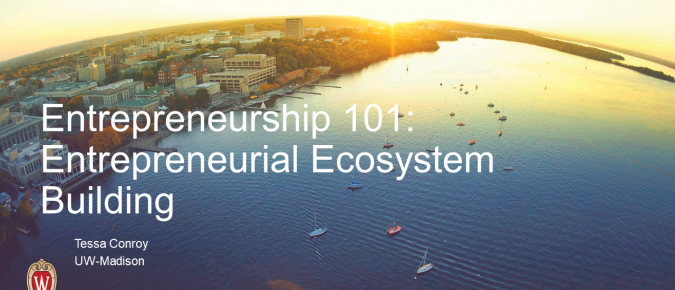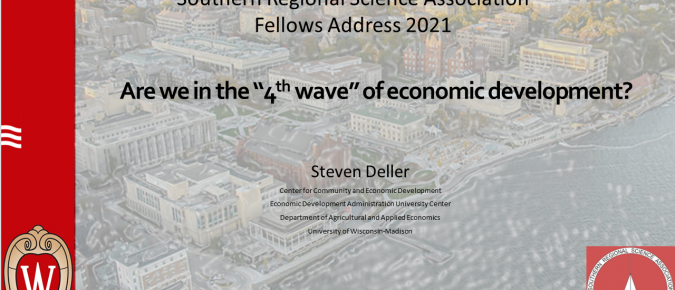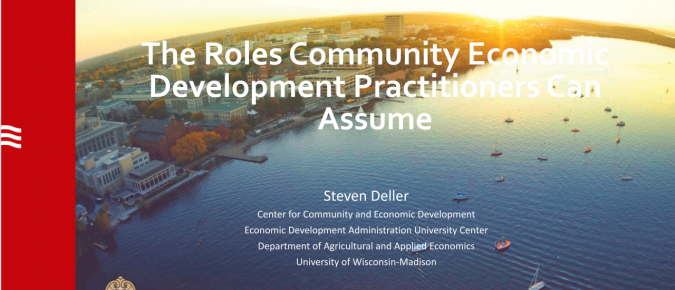Summary September 2021 — Real estate development professional and creative entrepreneur, Heidi Zimmer, discusses affordable housing in rural communities and shares her experience and perspective as a developer. Webinar Recording Additional Materials A Developer’s Perspective, PowerPoint About Our Presenter Heidi Zimmer is the founder of Wild Rice Retreat in Bayfield, Wisconsin, and President of Zimmer Development, LLC. […]
Community Vitality + Placemaking Fact Sheet Park(ing) Day Overview September 2021 — Park(ing) Day is an annual celebration of downtowns traditionally held on September 17. The original purpose of the celebration was to raise awareness of the amount of space dedicated to automobiles by temporarily reimagining individual parking spaces as parks, playgrounds, outdoor dining, and […]
Summary August 2021 — In the final session on entrepreneurship, Tessa Conroy, Assistant Professor of Agricultural and Applied Economics at UW–Madison and Community Economic Development Specialist, discusses “how to build an entrepreneurial ecosystem”. Webinar Recording Additional Materials Entrepreneurship 101, Part 3, PowerPoint Explore Our Lunch-n-Learn Series
Summary August 2021 — In part two of a three-part series on entrepreneurship, Tessa Conroy, Assistant Professor of Agricultural and Applied Economics at UW–Madison and Community Economic Development Specialist, discusses the “what” of entrepreneurship in economic development. Webinar Recording Additional Materials Entrepreneurship 101, Part 2, PowerPoint Explore Our Lunch-n-Learn Series
Summary August 2021 — In part one of a three-part series on entrepreneurship, Tessa Conroy, Assistant Professor of Agricultural and Applied Economics at UW–Madison and Community Economic Development Specialist, discusses the “why” of entrepreneurship in economic development. Webinar Recording Additional Materials Entrepreneurship 101, Part 1, PowerPoint Explore Our Lunch-n-Learn Series
Summary July 2022 — Stephanie Gutierrez, co-founder of Hope Nation, LLC, and author of “An Indigenous Approach to Community Wealth Building: A Lakota Translation”, and Cecily Englehart, Indigenous Community Wealth Building Coordinator with Hope Nation, LLC and the Advancement Director with the new nonprofit, Seven Fires, share their work on the transformative practice of building […]
Nonemployer establishments, sole proprietorships and partnerships without any paid employees, are an important part of the country’s economy. As of 2018, they made up a large and quickly growing share of businesses in the United States at 77% of the total while the other 23% of establishments were employer businesses [1]. Given that nonemployer establishments are businesses without employees, they are predominantly independent contractors who work for themselves or small businesses operated only by the owner(s) or unpaid members of their family.
June 2021 — This topic in Downtown Economics summarizes key points or “takeaways” from the recent webinar titled Shaping Downtown after COVID 19. The well-attended webinar highlighted examples of successful initiatives in four cities: Ithaca, New York, and Appleton, Eau Claire, and La Crosse Wisconsin. The following takeaways are presented without significant editing. You may […]
Summary May 2021 — Industry recruitment. Small business support. Public-private partnerships. These strategies characterize waves of economic development in the United States. Are we in the 4th wave of economic development? If so, what does this mean for economic development practitioners? Steve Deller, professor in agricultural and applied economics and community economic development specialist, discusses […]
Summary May 2021 — What type of community economic development practitioner are you? Do you emphasize the “C” (i.e., community)? The “E” (i.e., economic)? Or, the “D” (i.e., development)? Steve Deller, professor in agricultural and applied economics and community economic development specialist, describes several roles community economic development practitioners can assume. Webinar Recording Additional Materials […]
When one thinks about the term “business climate”, factors such as taxes, regulations, and unionization come to mind. These items tend to be viewed as potential costs that businesses face when making investment decisions. Anything that is viewed as increasing the costs of business operations is considered bad for the business climate of a community or region. To foster economic growth and development the business climate of the community or region must be enhanced. The logic follows that strategies or policies that reduce tax burdens, limit or reduce regulations, or weaken the strength of labor unions (e.g. Right-to-Work laws) will enhance business climate and foster economic growth and development.
Summary April 2021 — How did an isolated college town in the hills of Central New York assemble the economic development tools, talent, and relationships to shape its downtown as a treasured part of the community? What can economic development leaders from Appleton, Eau Claire, and La Crosse share about the outlook for their downtowns […]
















